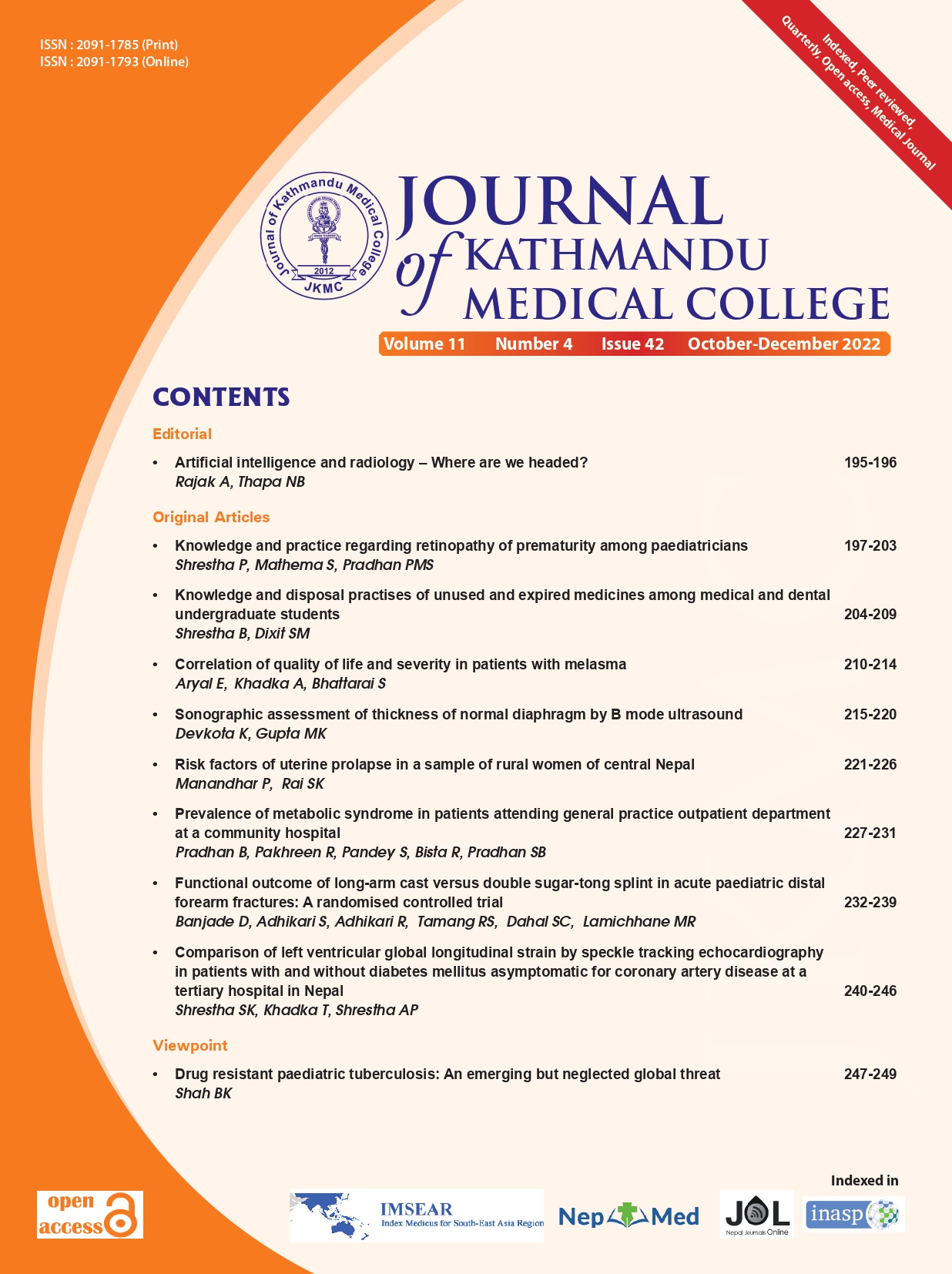Comparison of left ventricular global longitudinal strain by speckle tracking echocardiography in patients with and without diabetes mellitus asymptomatic for coronary artery disease at a tertiary hospital in Nepal
DOI:
https://doi.org/10.3126/jkmc.v11i4.53665Keywords:
Coronary artery disease, Diabetes mellitus, Global longitudinal strain, Silent myocardial ischaemia, Speckle tracking echocardiographyAbstract
Background: Diabetes mellitus is a major risk factor for cardiovascular events. A significant proportion of diabetics are asymptomatic for ischaemic heart disease either because of the early stage of ischaemia or silent myocardial ischaemia. Global longitudinal strain (GLS) of the left ventricle measured by speckle tracking echocardiography (STE) is a novel method of detecting left ventricular dysfunction due to myocardial ischaemia.
Objectives: This study aimed to compare the GLS of type-2 diabetes mellitus (T2DM) and non-diabetic patients who were asymptomatic for coronary artery disease (CAD).
Methods: An analytical cross-sectional study was conducted among 52 diabetic and 49 non-diabetic individuals asymptomatic for CAD presenting to a tertiary hospital, between 2022 September to 2022 October. The STE was performed to measure left ventricular GLS of the participants. Their blood and urine samples were sent for measuring glycosylated haemoglobin (HbA1c), total cholesterol, and microalbuminuria. Data were entered and analysed using SPSS v23.
Results: Twenty-five (48.1%) diabetics had left ventricular dysfunction (GLS ?18) compared to two (4.1%) non-diabetics. GLS was significantly lower among the diabetic patients, and exhibited significant inverse correlation with the duration of diabetes, age, HbA1c, and microalbuminuria (p <0.001). In multiple linear regression model for GLS, only the duration of diabetes (B = -0.27, p <0.001) and the age of patients (B = -0.057, p = 0.004) retained statistical significance, after adjusting for other covariates.
Conclusion: Left ventricular GLS has a significant negative correlation with the duration of diabetes and age of the patients.
Downloads
Downloads
Published
How to Cite
Issue
Section
License
Copyright (c) 2022 Journal of Kathmandu Medical College

This work is licensed under a Creative Commons Attribution-NonCommercial 4.0 International License.
Copyright © Journal of Kathmandu Medical College
The ideas and opinions expressed by authors or articles summarized, quoted, or published in full text in this journal represent only the opinions of the authors and do not necessarily reflect the official policy of Journal of Kathmandu Medical College or the institute with which the author(s) is/are affiliated, unless so specified.
Authors convey all copyright ownership, including any and all rights incidental thereto, exclusively to JKMC, in the event that such work is published by JKMC. JKMC shall own the work, including 1) copyright; 2) the right to grant permission to republish the article in whole or in part, with or without fee; 3) the right to produce preprints or reprints and translate into languages other than English for sale or free distribution; and 4) the right to republish the work in a collection of articles in any other mechanical or electronic format.




